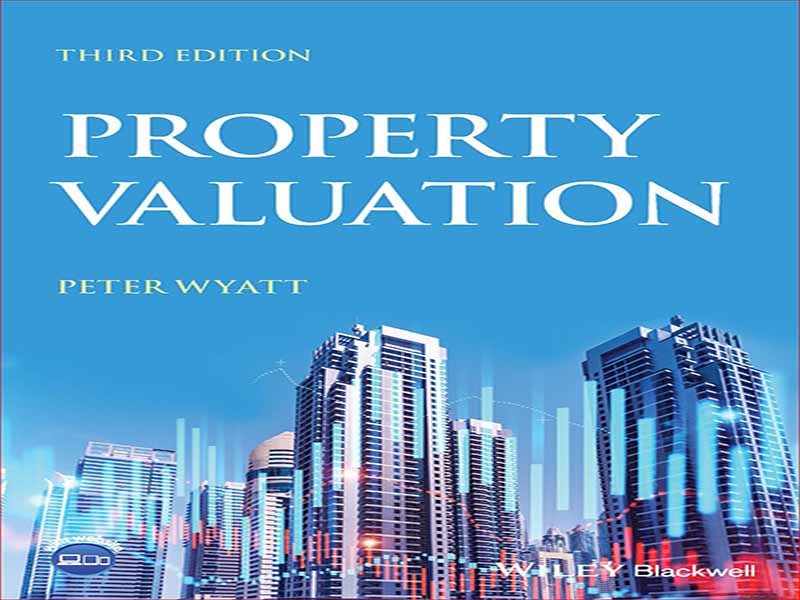- عنوان مجله: Property Valuation
- نویسنده: Peter Wyatt
- حوزه: َمدیریت اموال
- سال انتشار: 2022
- تعداد صفحه: 559
- زبان اصلی: انگلیسی
- نوع فایل: pdf
- حجم فایل: 6.25 مگابایت
مالکیت قانونی زمین و ساختمان که به عنوان «مالکیت غیرمنقول» نیز شناخته میشود و در سراسر این کتاب در مجموع از آن به عنوان مالکیت یاد میشود، حقوقی را اعطا میکند که امکان توسعه، تصرف یا اجاره آن را فراهم میکند. تصرف فیزیکی اموال برای فعالیت های اجتماعی و اقتصادی از جمله سرپناه، تولید، تجارت، تفریح و جابجایی ضروری است. به طور معمول، مالکیت فیزیکی دارایی به عنوان یک هدف به خودی خود مورد نظر نیست، اگرچه یک سایت معتبر یا ساختمان برجسته می تواند ارزش غیر مالی ایجاد کند. بلکه تقاضای مالکیت یک تقاضای مشتق است; متصرفان برای کمک به انجام فعالیت های اجتماعی و اقتصادی به دارایی نیاز دارند و سرمایه گذاران به ملک به عنوان دارایی سرمایه گذاری نیاز دارند. این مفهوم تقاضای مشتق شده ارتباط مستقیمی با ارزش گذاری آن دارد. تعامل بین عرضه و تقاضا برای ملک باعث ایجاد قیمت مبادله می شود و ارزش گذاری ها تخمینی از آن قیمت های بازار است. ارزشگذاران روشی را که شرکتکنندگان بازار ارزش را اندازهگیری و کمیت میکنند، تفسیر میکنند. به طور فزاینده ای، ارزشی فراتر از ارزش «بازار» به رسمیت شناخته می شود. به عنوان ارزش غیر بازاری شناخته می شود. مجموعه مهارت ارزشگذار معمولاً بر تخمین ارزش بازار متمرکز است، اما در برخی موارد ارزیابیهای اجتماعی و زیستمحیطی میتواند مکمل ارزشگذاری بازار باشد تا اطمینان حاصل شود که مالکان، اشغالکنندگان و سایر طرفهای متاثر از آن آگاه هستند و در صورت لزوم، به طور عادلانه برای هرگونه تداخل در آنها جبران میشود. حقوق مالکیت بخش A اصول ارزش گذاری را پوشش می دهد. فصل 1 با بحث در مورد حقوق مالکیت و روشی که از طریق آن این حقوق می تواند برای دارندگان آنها ارزش قائل شود آغاز می شود. فصل با توضیح اینکه چگونه و چرا ارزش گذاری به عنوان یک رشته برای کمک به تخمین ارزش آن حقوق مالکیت تکامل یافته به پایان می رسد. فصل 2 به تشریح ارزش اقتصادی یا دارایی مربوط به بازارهای دارایی و برآورد قیمت مبادله میپردازد. اصطلاحات و مفاهیم اقتصادی مرتبط با عرضه و تقاضای ملک، مفهوم اجاره به عنوان پرداختی برای استفاده از آنها و برخی از نظریه های کاربری زمین را معرفی می کند. این توضیح میدهد که چگونه ارزشهای دارایی با استفاده از اصول و تئوریهای اقتصادی که در طول یک قرن و نیم گذشته توسعه و تبیین شدهاند، به وجود میآیند. با تکیه بر نظریه های مربوط به بازار زمین کشاورزی، علل و توزیع فضایی زمین و کاربری های شهری و املاک و اجاره ها تشریح می شود. این فصل به بررسی اقتصاد عرضه و تقاضا و ایجاد تعادل قیمت مبادله ای در بازار املاک و بخش های تشکیل دهنده آن می پردازد. این فصل علل تفاوت قیمت بین کاربری ها را توضیح می دهد. فصل 3 بخش های اصلی بازار املاک – اشغال، سرمایه گذاری و توسعه – و نحوه تعامل آنها با یکدیگر را شرح می دهد. فصل 4 ریاضیاتی را توضیح می دهد که زیربنای روش های ارزش گذاری شرح داده شده در بخش B هستند. بخش B رویکردهای ارزش گذاری را پوشش می دهد. با فصل 5 شروع می شود که فرآیند ارزیابی را از تأیید دستورالعمل ارزش گذاری یک ملک تا انتشار گزارش ارزیابی شرح می دهد. فصلهای 6، 7 و 8 روشها و تکنیکهای ارزشگذاری را توضیح میدهند که تحت سه رویکرد شناختهشده بینالمللی برای ارزیابی دارایی – بازار، درآمد و هزینه قرار میگیرند. هر روشی که به کار گرفته شود، باید منعکس کننده رفتار فعالان بازار باشد. شکل زیر نشان می دهد که در بازارهای فعال، که در آن مقادیر زیادی از معاملات شامل املاک با ویژگی های مشابه وجود دارد، نقش ارزش گذار اساساً تفسیر سیگنال های بازار و اعمال آنها بر روی دارایی موضوع است – یک رویکرد مقایسه. با در دسترس بودن محدود اطلاعات بازار، روش های ارزش گذاری بازار به طور فزاینده ای مبتنی بر هزینه هستند. ارزشگذاران باید مفروضات بیشتری داشته باشند و این عدم قطعیت ارزشگذاری را افزایش میدهد.
The legal ownership of land and buildings, also known as ‘real property’ and collectively referred to as property throughout this book, confers rights that enable it to be developed, occupied or leased. The physical occupation of property is essential for social and economic activities including shelter, manufacture, commerce, recreation and movement. Typically, physical property ownership is not desired as an end in itself, although a prestigious site or landmark building can confer non-financial value. Rather, demand for property is a derived demand; occupiers require property to help deliver social and economic activities, and investors require property as an investment asset. This concept of derived demand has a direct bearing on its valuation. The interaction between the supply of and demand for property generates exchange prices and valuations are estimates of those market prices. Valuers interpret the way in which market participants measure and quantify value. Increasingly, there is recognition of value beyond ‘market’ value; referred to as non-market value. The valuer’s skill set has conventionally focused on the estimation of market value but in some cases social and environmental assessments can complement market valuations to ensure that owners, occupiers and other affected parties are aware of and, if appropriate, fairly compensated for any interference with their property rights. Section A covers valuation principles. Chapter 1 begins with a discussion on property rights and the way in which those rights can confer value to their holders. The chapter ends by explaining how and why valuation has evolved as a discipline to help estimate the value of those property rights. Chapter 2 outlines the economics or property value relevant to property markets and estimates of exchange price. It introduces economic terms and concepts associated with the supply of and demand for property, the concept of rent as a payment for their use and some land-use theory. It explains how property values arise using economic principles and theories that have been developed and expounded over the past century and a half. Building on the theories relating to the agricultural land market, the causes and spatial distribution of urban land and property uses and rents are described. The chapter examines the economics of supply and demand and the establishment of equilibrium exchange price in the property market and its constituent sectors. The chapter explains the causes of price differentials between land uses. Chapter 3 describes the main property market sectors – occupation, investment and development – and the way that they interact with one another. Chapter 4 explains the mathematics that underpin the valuation methods described in Section B. Section B covers valuation approaches. It begins with Chapter 5, which describes the valuation process, from confirmation of the instruction to value a property through to the publication of a valuation report. Chapters 6, 7 and 8 explain the valuation methods and techniques that fall under the three internationally recognised approaches to property valuation – market, income and cost. Whichever method is employed, it should reflect the behaviour of market participants. The figure below shows that in active markets, where there is a large quantity of transactions involving properties with similar characteristics, the role of the valuer is essentially to interpret market signals and apply them to the subject property – a comparison approach. With limited availability of market information, market-valuation methods are increasingly cost-based. Valuers are required to make more assumptions, and this increases valuation uncertainty.
این کتاب را میتوانید از لینک زیر بصورت رایگان دانلود کنید:
Download: Property Valuation



































نظرات کاربران